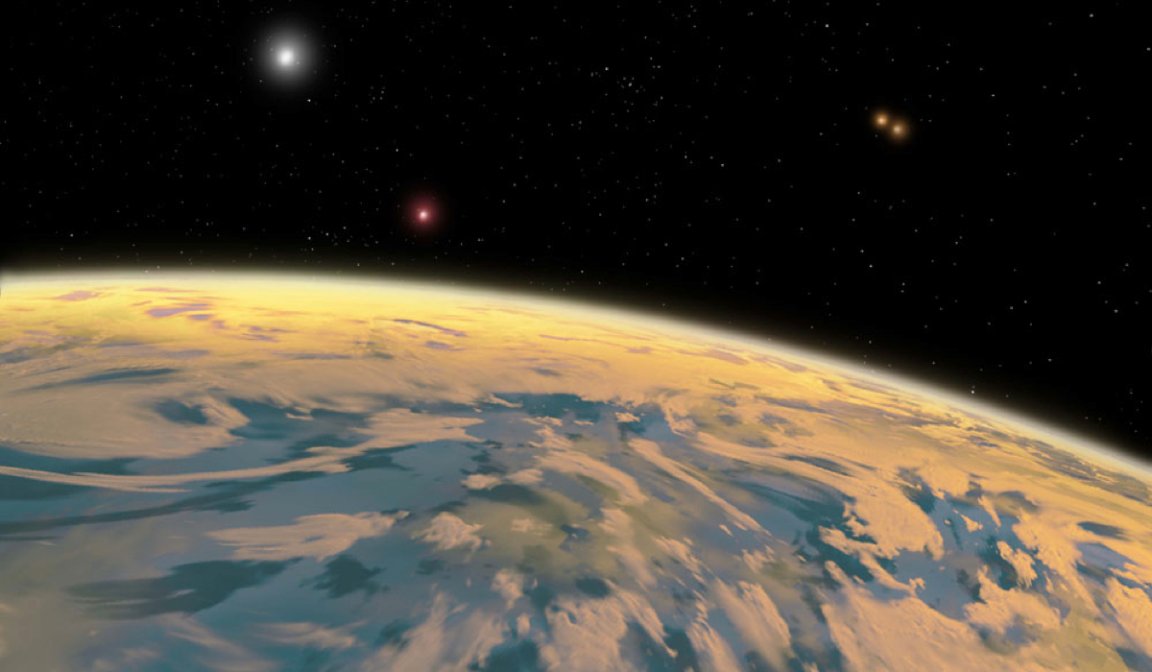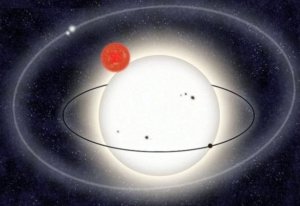

In the Star Wars series the protagonist of the movies, Luke Skywalker, hails from a planet in a galaxy, far, far away that circled two suns.
The planet is named Tatooine. In another classic case of science fiction turning into science fact, astronomers found a planet circling not two, but four stars. The most amazing aspect of this find? The planet was discovered by two “armchair” astronomers!
There are many different methods astronomers utilize to find exoplanets, also known as extrasolar planets or alien worlds. One such method used by scientists is the transit method. It essentially monitors select stars, in hopes of observing telltale blimps in the luminosity of the star’s light, which is obstructed as a planet transits the face of the star directly in our path of vision.
Observing these so-called blimps of light can be tedious work for astronomers due to the sheer number of stars in the Milky Way. So the “Planet Hunters” project was thought up as a way to discover new transiting exoplanets and also get the public interested in astronomy (and other branches of planetary science).
Here, participants can pour through the data collected from 150,000 stars by the Kepler Space telescope looking for these blimps of light. This is how this planet was discovered – by people just like you.
Meet the Planet
Formally dubbed PH1 (“PH” after “Planet Hunters,” the project credited with the discovery) — this undoubtedly bright new world lies about 5,000 light-years from Earth. It comes in with a radius that exceeds our home world 6 times (it’s about five times more massive). This means that the planet is only a small fraction larger than Neptune, the outermost icy giant of our solar system.
Yet unlike Neptune, which takes 165 years to make one lap around the Sun, PH1 only takes 138 days to complete a single orbit around its two ‘primary’ parent stars (one is about 1.5 times larger than the Sun, while the other is about 0.41% more massive). The two stars are in a tight orbit that sees them make one full circle around each other once every 20 days!

Here’s where things get kind of tricky. The other two stars in the planetary system orbit the primary stars from a distance of about 1,000 AU (1 AU is the distance that separates the Earth and the Sun, which equals out to about 93 million miles [150 million km]).
Our solar system is estimated to extend some 160 AUs from the Sun, which is the region where the Sun’s gravitational influence on solar winds starts to dwindle (we call this the ‘heliosphere.’) Obviously, there is quite a bit of distance between the pair of star systems, but that distance is nothing when compared to the distances that typically separate stars and/or planets.
Don’t expect any extra-terrestrial beings to be able to catch a quadruple sunset or sunrise though, this planet is likely composed of gas and is blisteringly hot. The estimates for the temperatures are between 484 degrees Fahrenheit (524 Kelvin, or 251 degrees Celsius) and 644 degrees F (613 Kelvin, or 340 degrees C) — effectively putting the planet outside of the theoretical Goldilocks region of the planetary system (the place where liquid water may exist on the surface without freezing or evaporating. You know, if the planet even had a surface).
Is the Planet Rare?
Actually, no. Astronomers have known for a while now that a large portion of the stars in our galaxy belong to multiple star systems. They’ve also found that many binary star systems are locked in tight orbits around other pairs of binary stars. They’ve even found a handful of “Tatooine-like” exoplanets, called circumbinary planets, orbiting a pair of stars.

This, however, was the first discovery of its kind. Prior to it, no other exoplanet had ever been discovered orbiting binary stars that, in turn, have stellar companions orbiting them. It’s an interesting find that ultimately challenges our planetary formation theories, which can’t currently explain how a planetesimal could evolve into a fully-fledged planet in such a chaotic environment.
If you’re interested in discovering your own planet — perhaps in hopes of having a planet named after you eventually (hey, we can dream right?) — You can learn more about the Planet Hunters project, which runs solely on volunteers like YOU, here.
FQTQ is managed by two people, Jaime and Jolene. We want to make science fun and engaging. We’re doing that. With your help, we can do even more.
Below you can support us, get to know us, and access extra content: